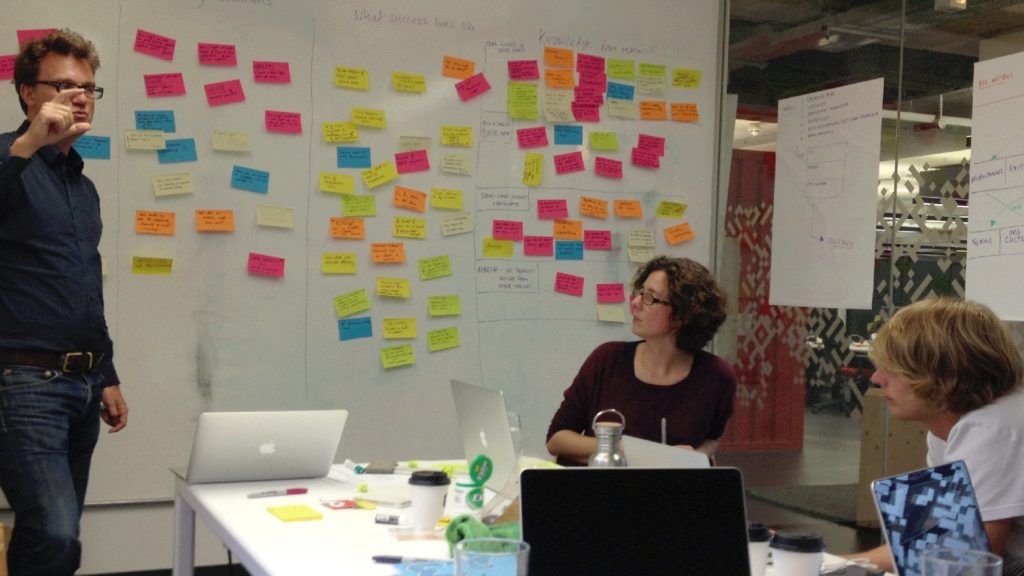Key Takeaway
The team at Saberr are looking to improve team dynamics and make the workplace happier, using data and machine learning. Their CoachBot software acts as a team coach, bringing in insights from external data, to help teams to better align and improve efficiency.
We spoke with Jennifer Dawson, Head of Marketing at HR tech startup Saberr, to learn more about the science behind Saberr’s CoachBot, as well as their thoughts on the future of data in the HR space.
Saberr was founded by Alistair Shepherd in 2013, while he was studying at Harvard under Noam Wasserman (author of The Founder’s Dilemmas). They were looking at reasons why startups failed (at a rate of 83%). What the research showed was that 65% of failures (VC-backed) happened because of team dynamics. “One of the only things you can control is who you hire, so this shouldn’t be why you fail.”
Diving into problems related to team and culture, he decided to take a closer look at what it is that makes people get along. He started with online dating. Shepherd evaluated 3.5M data points to discover what was most predictive of a successful match and found that values-based questions were most accurate. He and his team then explored this in a business context, creating what became the Saberr Base survey.
They tested the survey with a business plan competition. The Saberr team hadn’t met anyone taking part in the competition and didn’t know anything about them yet. At the end of the week, when the results came out, Base had accurately predicted the winners. Not only that; they predicted the 1-8 ranking precisely correct. They repeated this again at Microsoft with similar results and realized they were onto something.

Data shows team alignment affects performance
Shepherd’s team developed an algorithm that combined the science of values and personality (using the Big 5 + Schwartz personality theories), and the results of the 15 minute Base survey, to look at values alignment between people as well as tolerance to determine a potential fit.
“The most important thing about a job is the people around you, so we always look at the candidate in context of the team. If two candidates have similar skills, Saberr can determine how likely they are to get on with the team based on values and personality.”
According to the Saberr team, values and core motivations alignment indicates higher overall team performance. “In a sales company, we looked at the difference between teams with high values alignment and low values alignment and found that the team with high alignment generated 1.9x more revenue than the team with low alignment. Teams that work well together have better outcomes for the business and are overall happier.”
When it comes to hiring, Saberr’s sweet spot lies in helping companies to determine cultural fit for a viable candidate. “We look at each person as an individual, so you’re not not saying ‘we hired someone like this person in the past and it worked.’ It’s like having another voice in the room. Instead of a disagreement between two people, data can be the tie breaker.”
Beyond recruitment: CoachBot aims to improve output, retention
The Base product looks at values and personality, and once the candidate has been hired, CoachBot evaluates everything else: roles and responsibilities, goals and purpose, decision making, network, productivity and relationships. It looks at score and also team context: remote vs co-located, time dedicated to improving teamwork, etc. From this data it can establish what is best for improving productivity.

“Essentially CoachBot is a digital team coach. It’s like a human coach that delivers high quality coaching. But unlike a human who leaves and comes back say once a quarter, this fills the gaps to make sure the teams are adhering to what they’ve learned.”
CoachBot makes coaching accessible to entire teams across an organization, ensuring the impact is not limited to senior executives. “Often, coaching is limited to very senior teams. It’s valuable so it tends to be expensive and often involves days out of office. But because CoachBot is digital, it can be used anytime anywhere and can scale to the whole team.”
The bot uses machine learning, with external data fed from human team coaches and organizational psychologists, as well as academic papers. It includes exercises from world’s best organizational coaches. As the product gets more users, CoachBot will understand what works best for different teams in different contexts.
“CoachBot learns from users over time. Teams don’t spend a lot of time interacting with it; rather, it nudges them and helps them facilitate their own development, and gives them prompts to talk to one another and develop together. The outcome is much higher productivity and efficiency.”
CoachBot offers external insights to help teams find new ways to drive performance that are customized to their needs.
“If everyone has access to the world’s most experienced team coach, you can reach your goals faster, make work a happier place, and not spend ages not making a decision or knowing which direction you’re going. The idea is that people are happier at work because they get along better.”

Empowering HR teams with data-driven decisions
With data from CoachBot, individual teams within an organization will have the ability to solve some of their own problems rather than coming to HR. “At the moment, HR teams are often presented with a huge list of problems. Then they have to decide which problems are the highest priority, which to fix first, and they can’t solve them all.”
If others have the autonomy to better manage their own team issues, the HR team can then look across the business broadly to discover trends, and look at the data to see what needs improvement and what issues are coming up consistently across the board.
It’s been proven that happiness in the workplace leads to higher productivity. With increasing competition for talent, and more and more data-driven recruitment to better match employers with qualified candidates, the door is open for external data insights to also transform the current employee experience across an organization.

